Membrane CO2 Separation System Improvement for Coal-Fired Power Plant Integration
Abstract
1. Introduction
1.1. Background
1.2. Research Progress
1.3. Target and Novelty of the Current Article
2. Methodology
2.1. Membrane Mathematical Model
2.2. Membrane CO2 Recovery Design
| Agent | Unit | Rate |
|---|---|---|
| Hard coal details | 72.30% Carbon, 4.11% Hydrogen, 1.69% Nitrogen, 7.45% Oxygen, 0.56% Sulphur, 13.89% ash. | |
| Lower heating value | MJ/kg | 25.17 |
| CFPP main characteristics | ||
| Temperature of steam | °C | 560 |
| Pressure of steam | bar | 170 |
| Steam turbine efficiency (high pressure) | % | 84.9 |
| Steam turbine efficiency (medium pressure) | % | 91.6 |
| Steam turbine efficiency (low pressure) | % | 87.8 |
| Pressure of condensing | bar | 0.05 |
| Condenser cooling water | °C | 9.5 |
| Steam generator combustion efficiency | % | 91 |
| Flux steam | t/h | 914.5 |
| CFPP net efficiency | % | 45.87 |
| Flue gas details before membrane technology | ||
| Pressure | MPa | 0.101 |
| Temperature | °C | 50 |
| Flux | kmol/h | 40,320 |
| Flue gas composition | %mole | |
| CO2 | 13.12 | |
| N2 | 80.82 | |
| O2 | 6.03 | |
| SO2 | 0.03 |
2.3. Techno-Economic Evaluation Structure
3. Results and Discussion
3.1. Effect of First Compressor Pressure and Membrane Area on CO2 Capture Efficiency
3.2. Effect of First Compressor Pressure and Membrane Area on Total Power Consumption
3.3. Effect of First Compressor Pressure and Membrane Area on CO2 Purity
3.4. Effect of Second Compressor Pressure on CO2 Purity
3.5. Main Results of the Techno-Economic Assessment
3.6. Benefits of Expander Use
3.7. Comparision between Our Optimum Outcomes and Others from the Literature
4. Conclusions
Author Contributions
Funding
Institutional Review Board Statement
Informed Consent Statement
Data Availability Statement
Conflicts of Interest
Abbreviations
| CFPP | Coal-fired power plant |
| Log mean diameter of membrane module, μm | |
| Effective thickness of membrane module, μm | |
| Membrane module diameter (inside), μm | |
| Membrane module diameter (outside), μm | |
| Feed flow rate, kmol/h | |
| Feed flow rate in the membrane entry, kmol/h | |
| Normalized feed flow rate | |
| Total length of membrane module, m | |
| Potted length of membrane module, m | |
| Feed pressure in membrane entry, bar | |
| Feed pressure, bar | |
| Permeate pressure, bar | |
| CO2 permeability, GPU | |
| N2 permeability, GPU | |
| Gas constant, mol K m−3 kPa−1 | |
| Temperature, K | |
| Total power consumed by compressors | |
| Total power recovered by expander | |
| Permeate flow rate, kmol/h | |
| Permeate flow rate at membrane entry, kmol/h | |
| Permeate flow rate (dimensionless) | |
| Feed CO2 mole fraction | |
| Feed CO2 mole fraction at membrane entry | |
| Permeate CO2 mole fraction | |
| Permeate CO2 mole fraction at membrane entry | |
| α | CO2/N2 selectivity |
| CO2 viscosity, bars | |
| Levelized cost of electricity | |
| Specific primary energy consumption for carbon dioxide avoided | |
| CCS | Carbon capture system |
| CP1 | First compressor pressure |
| CP2 | Second compressor pressure |
| MSA1 | First membrane area |
| MSA2 | Second membrane area |
| Carbon dioxide released without CCS | |
| Carbon dioxide released with CCS | |
| CO2 captured cost | |
| CO2 avoided cost | |
| Net present value | |
| DPP | Discount payback period |
| IRR | Internal rate of return |
| Replacement cost in a year | |
| Recompense loan in a year | |
| Actual investment in a year | |
| Rate of discount | |
| Profitability index | |
| Deduct from the investment |
References
- Ge, M.; Lebling, K.; Levin, K.; Friedrich, J. Tracking Progress of the 2020 Climate Turning Point; World Resources Institute: Washington, DC, USA, 2019. [Google Scholar]
- Iea, I. World Energy Statistics and Balances; IEA: Paris, France, 2019. [Google Scholar]
- Risso, R.; Cardona, L.; Archetti, M.; Lossani, F.; Bosio, B.; Bove, D. A Review of On-Board Carbon Capture and Storage Techniques: Solutions to the 2030 IMO Regulations. Energies 2023, 16, 6748. [Google Scholar] [CrossRef]
- Songolzadeh, M.; Soleimani, M.; Ravanchi, M.T.; Songolzadeh, R. Carbon dioxide separation from flue gases: A technological review emphasizing reduction in greenhouse gas emissions. Sci. World J. 2014, 828131. [Google Scholar] [CrossRef]
- Thepsaskul, W.; Wongsapai, W.; Sirisrisakulchai, J.; Jaitiang, T.; Daroon, S.; Raksakulkan, V.; Muangjai, P.; Ritkrerkkrai, C.; Suttakul, P.; Wattakawigran, G. Potential Business Models of Carbon Capture and Storage (CCS) for the Oil Refining Industry in Thailand. Energies 2023, 16, 6955. [Google Scholar] [CrossRef]
- Rajulwar, V.V.; Shyrokykh, T.; Stirling, R.; Jarnerud, T.; Korobeinikov, Y.; Bose, S.; Bhattacharya, B.; Bhattacharjee, D.; Sridhar, S. Steel, Aluminum, and FRP-Composites: The Race to Zero Carbon Emissions. Energies 2023, 16, 6904. [Google Scholar] [CrossRef]
- Wilkes, M.D.; Brown, S. Flexible CO2 capture for open-cycle gas turbines via vacuum-pressure swing adsorption: A model-based assessment. Energy 2022, 250, 123805. [Google Scholar] [CrossRef]
- Pascu, A.; Stoica, L.; Dinca, C.; Badea, A. The package type influence on the performance of the CO2 capture process by chemical absorption. UPB Sci. Bull. Ser. C 2016, 78, 259–270. [Google Scholar]
- Alabid, M.; Slavu, N.; Sandru, M.; Dinca, C. Hybrid polymeric membrane–chemical absorption system for pre-combustion CO2 capture. In Computer Aided Chemical Engineering; Elsevier: Athens, Greece, 2023; pp. 3073–3078. [Google Scholar]
- Bravo, J.; Drapanauskaite, D.; Sarunac, N.; Romero, C.; Jesikiewicz, T.; Baltrusaitis, J. Optimization of energy requirements for CO2 post-combustion capture process through advanced thermal integration. Fuel 2021, 283, 118940. [Google Scholar] [CrossRef]
- Spitoni, M.; Pierantozzi, M.; Comodi, G.; Polonara, F.; Arteconi, A. Theoretical evaluation and optimization of a cryogenic technology for carbon dioxide separation and methane liquefaction from biogas. J. Nat. Gas Sci. Eng. 2019, 62, 132–143. [Google Scholar] [CrossRef]
- Darunte, L.A.; Walton, K.S.; Sholl, D.S.; Jones, C.W. CO2 capture via adsorption in amine-functionalized sorbents. Curr. Opin. Chem. Eng. 2016, 12, 82–90. [Google Scholar] [CrossRef]
- Liu, Y.; Yang, Y.; Sun, Q.; Wang, Z.; Huang, B.; Dai, Y.; Qin, X.; Zhang, X. Chemical adsorption enhanced CO2 capture and photoreduction over a copper porphyrin based metal organic framework. ACS Appl. Mater. Interfaces 2013, 5, 7654–7658. [Google Scholar] [CrossRef]
- Xu, J.; Wu, H.; Wang, Z.; Qiao, Z.; Zhao, S.; Wang, J. Recent advances on the membrane processes for CO2 separation. Chinese J. Chem. Eng. 2018, 26, 2280–2291. [Google Scholar] [CrossRef]
- Yang, H.; Xu, Z.; Fan, M.; Gupta, R.; Slimane, R.B.; Bland, A.E.; Wright, I. Progress in carbon dioxide separation and capture: A review. J. Environ. Sci. 2008, 20, 14–27. [Google Scholar] [CrossRef] [PubMed]
- Alabid, M.; Dinca, C. Parametrization Study for Optimal Pre-Combustion Integration of Membrane Processes in BIGCC. Sustainability 2022, 14, 16604. [Google Scholar] [CrossRef]
- Roussanaly, S.; Anantharaman, R.; Lindqvist, K.; Zhai, H.; Rubin, E. Membrane properties required for post-combustion CO2 capture at coal-fired power plants. J. Memb. Sci. 2016, 511, 250–264. [Google Scholar] [CrossRef]
- Hussain, A.; Farrukh, S.; Minhas, F.T. Two-stage membrane system for post-combustion CO2 capture application. Energy Fuels 2015, 29, 6664–6669. [Google Scholar] [CrossRef]
- Kárászová, M.; Zach, B.; Petrusová, Z.; Červenka, V.; Bobák, M.; Šyc, M.; Izák, P. Post-combustion carbon capture by membrane separation, Review. Sep. Purif. Technol. 2020, 238, 116448. [Google Scholar] [CrossRef]
- Pal, N.; Agarwal, M. Advances in materials process and separation mechanism of the membrane towards hydrogen separation. Int. J. Hydrogen Energy 2021, 46, 27062–27087. [Google Scholar] [CrossRef]
- Brunetti, A.; Drioli, E.; Lee, Y.M.; Barbieri, G. Engineering evaluation of CO2 separation by membrane gas separation systems. J. Memb. Sci. 2014, 454, 305–315. [Google Scholar] [CrossRef]
- White, L.S.; Wei, X.; Pande, S.; Wu, T.; Merkel, T.C. Extended flue gas trials with a membrane-based pilot plant at a one-ton-per-day carbon capture rate. J. Memb. Sci. 2015, 496, 48–57. [Google Scholar] [CrossRef]
- Lee, S.; Binns, M.; Lee, J.H.; Moon, J.-H.; Yeo, J.-G.; Yeo, Y.-K.; Lee, Y.M.; Kim, J.-K. Membrane separation process for CO2 capture from mixed gases using TR and XTR hollow fiber membranes: Process modeling and experiments. J. Memb. Sci. 2017, 541, 224–234. [Google Scholar] [CrossRef]
- Robeson, L.M. The upper bound revisited. J. Memb. Sci. 2008, 320, 390–400. [Google Scholar] [CrossRef]
- Da Conceicao, M.; Nemetz, L.; Rivero, J.; Hornbostel, K.; Lipscomb, G. Gas Separation Membrane Module Modeling: A Comprehensive Review. Membranes 2023, 13, 639. [Google Scholar] [CrossRef]
- Belaissaoui, B.; Lasseuguette, E.; Janakiram, S.; Deng, L.; Ferrari, M.-C. Analysis of CO2 facilitation transport effect through a hybrid poly (allyl amine) membrane: Pathways for further improvement. Membranes 2020, 10, 367. [Google Scholar] [CrossRef] [PubMed]
- Fu, Q.; Halim, A.; Kim, J.; Scofield, J.M.P.; Gurr, P.A.; Kentish, S.E.; Qiao, G.G. Highly permeable membrane materials for CO2 capture. J. Mater. Chem. A 2013, 1, 13769–13778. [Google Scholar] [CrossRef]
- Low, B.T.; Zhao, L.; Merkel, T.C.; Weber, M.; Stolten, D. A parametric study of the impact of membrane materials and process operating conditions on carbon capture from humidified flue gas. J. Memb. Sci. 2013, 431, 139–155. [Google Scholar] [CrossRef]
- Sandru, M.; Haukebø, S.H.; Hägg, M.-B. Composite hollow fiber membranes for CO2 capture. J. Memb. Sci. 2010, 346, 172–186. [Google Scholar] [CrossRef]
- Li, Q.; Wu, H.; Wang, Z.; Wang, J. Analysis and optimal design of membrane processes for flue gas CO2 capture. Sep. Purif. Technol. 2022, 298, 121584. [Google Scholar] [CrossRef]
- Gilassi, S.; Taghavi, S.M.; Rodrigue, D.; Kaliaguine, S. Optimizing membrane module for biogas separation. Int. J. Greenh. Gas Control 2019, 83, 195–207. [Google Scholar] [CrossRef]
- Xu, J.; Wang, Z.; Qiao, Z.; Wu, H.; Dong, S.; Zhao, S.; Wang, J. Post-combustion CO2 capture with membrane process: Practical membrane performance and appropriate pressure. J. Memb. Sci. 2019, 581, 195–213. [Google Scholar] [CrossRef]
- Wu, H.; Li, Q.; Sheng, M.; Wang, Z.; Zhao, S.; Wang, J.; Mao, S.; Wang, D.; Guo, B.; Ye, N.; et al. Membrane technology for CO2 capture: From pilot-scale investigation of two-stage plant to actual system design. J. Memb. Sci. 2021, 624, 119137. [Google Scholar] [CrossRef]
- Micari, M.; Dakhchoune, M.; Agrawal, K.V. Techno-economic assessment of postcombustion carbon capture using high-performance nanoporous single-layer graphene membranes. J. Memb. Sci. 2021, 624, 119103. [Google Scholar] [CrossRef]
- Ciferno, J.; Plasynski, S.I. Advanced Carbon Dioxide Capture R&D Program: Technology Update. Report DOE/NETL, 2010. Available online: https://www.mcilvainecompany.com/Decision_Tree/subscriber/CO2DescriptionTextLinks/DOENETL2010UpdateReport.pdf (accessed on 15 December 2023).
- Peletiri, S.P.; Rahmanian, N.; Mujtaba, I.M. CO2 Pipeline design: A review. Energies 2018, 11, 2184. [Google Scholar] [CrossRef]
- Sandru, M.; Kim, T.-J.; Capala, W.; Huijbers, M.; Hägg, M.-B. Pilot scale testing of polymeric membranes for CO2 capture from coal fired power plants. Energy Procedia 2013, 37, 6473–6480. [Google Scholar] [CrossRef]
- Lillepärg, J.; Georgopanos, P.; Shishatskiy, S. Stability of blended polymeric materials for CO2 separation. J. Memb. Sci. 2014, 467, 269–278. [Google Scholar] [CrossRef]
- Sidhoum, M.; Sengupta, A.; Sirkar, K.K. Asymmetric cellulose acetate hollow fibers: Studies in gas permeation. AIChE J. 1988, 34, 417–425. [Google Scholar] [CrossRef]
- Sengupta, A.; Sirkar, K.K. Ternary gas mixture separation in two-membrane permeators. AIChE J. 1987, 33, 529–539. [Google Scholar] [CrossRef]
- Boucif, N.; Sengupta, A.; Sirkar, K.K. Hollow fiber gas permeator with countercurrent or cocurrent flow: Series solutions. Ind. Eng. Chem. Fundam. 1986, 25, 217–228. [Google Scholar] [CrossRef]
- Ramírez-Santos, Á.A.; Bozorg, M.; Addis, B.; Piccialli, V.; Castel, C.; Favre, E. Optimization of multistage membrane gas separation processes. Example of application to CO2 capture from blast furnace gas. J. Memb. Sci. 2018, 566, 346–366. [Google Scholar] [CrossRef]
- Chiwaye, N.; Majozi, T.; Daramola, M.O. Optimisation of post-combustion carbon dioxide capture by use of a fixed site carrier membrane. Int. J. Greenh. Gas Control 2021, 104, 103182. [Google Scholar] [CrossRef]
- Taifan, G.S.P.; Maravelias, C.T. Generalized optimization-based synthesis of membrane systems for multicomponent gas mixture separation. Chem. Eng. Sci. 2022, 252, 117482. [Google Scholar] [CrossRef]
- Pan, C.Y. Gas separation by high-flux, asymmetric hollow-fiber membrane. AIChE J. 1986, 32, 2020–2027. [Google Scholar] [CrossRef]
- Alabid, M.; Dinca, C. Parametrical Assessment of Polyacrylamide Polymer Membrane Used for CO2 Post-Combustion Capture. Appl. Sci. 2023, 13, 11333. [Google Scholar] [CrossRef]
- Hao, J.; Rice, P.A.; Stern, S.A. Upgrading low-quality natural gas with H2S-and CO2-selective polymer membranes: Part II. Process design, economics, and sensitivity study of membrane stages with recycle streams. J. Memb. Sci. 2008, 320, 108–122. [Google Scholar] [CrossRef]
- Datta, A.K.; Sen, P.K. Optimization of membrane unit for removing carbon dioxide from natural gas. J. Memb. Sci. 2006, 283, 291–300. [Google Scholar] [CrossRef]
- Shao, P.; Dal-Cin, M.M.; Guiver, M.D.; Kumar, A. Simulation of membrane-based CO2 capture in a coal-fired power plant. J. Memb. Sci. 2013, 427, 451–459. [Google Scholar] [CrossRef]
- Brasington, R.D.; Haslback, J.L.; Kuehn, N.J.; Lewis, E.G.; Pinkerton, L.L.; Turner, M.J.; Varghese, E.; Woods, M. Cost and Performance Baseline for Fossil Energy Plants-Volume 2: Coal to Synthetic Natural Gas and Ammonia; National Energy Technology Laboratory (NETL): Pittsburgh, PA, USA; Morgantown, WV, USA, 2011. [Google Scholar]
- Freeman, B.; Hao, P.; Baker, R.; Kniep, J.; Chen, E.; Ding, J.; Zhang, Y.; Hybrid, G.T.R. Membrane-absorption CO2 capture process. Energy Procedia 2014, 63, 605–613. [Google Scholar] [CrossRef]
- Chowdhury, M.H.M. Simulation, Design and Optimization of Membrane Gas Separation, Chemical Absorption and Hybrid Processes for CO2 Capture. Ph.D. Thesis, University of Waterloo, Waterloo, ON, Canada, 2012. [Google Scholar]
- Alabid, M.; Cormos, C.C.; Dinca, C. Critical Assessment of Membrane Technology Integration in a Coal-Fired Power Plant. Membranes 2022, 12, 904. [Google Scholar] [CrossRef]
- Koros, W.J.; Chern, R.T. Separation of gaseous mixtures using polymer membranes. In Handbook of Separation Process Technology; Wiley: New York, NY, USA, 1987; pp. 862–953. [Google Scholar]
- Yun, S.; Jang, M.-G.; Kim, J.-K. Techno-economic assessment and comparison of absorption and membrane CO2 capture processes for iron and steel industry. Energy 2021, 229, 120778. [Google Scholar] [CrossRef]
- Ji, G.; Zhao, M. Membrane separation technology in carbon capture. In Recent Advances in Carbon Capture and Storage; IntechOpen: Rijeka, Croatia, 2017; pp. 59–90. [Google Scholar]
- Vega, F.; Baena-Moreno, F.M.; Fernández, L.M.G.; Portillo, E.; Navarrete, B.; Zhang, Z. Current status of CO2 chemical absorption research applied to CCS: Towards full deployment at industrial scale. Appl. Energy 2020, 260, 114313. [Google Scholar] [CrossRef]
- Chen, Y.; Wang, B.; Zhao, L.; Dutta, P.; Ho, W.S.W. New Pebax®/zeolite Y composite membranes for CO2 capture from flue gas. J. Memb. Sci. 2015, 495, 415–423. [Google Scholar] [CrossRef]
- Han, Y.; Yang, Y.; Ho, W.S.W. Recent progress in the engineering of polymeric membranes for CO2 capture from flue gas. Membranes 2020, 10, 365. [Google Scholar] [CrossRef] [PubMed]
- Yun, S.; Oh, S.-Y.; Kim, J.-K. Techno-economic assessment of absorption-based CO2 capture process based on novel solvent for coal-fired power plant. Appl. Energy 2020, 268, 114933. [Google Scholar] [CrossRef]
- Cormos, A.-M.; Dinca, C.; Cormos, C.-C. Energy efficiency improvements of post-combustion CO2 capture based on reactive gas–liquid absorption applied for super-critical circulating fluidized bed combustion (CFBC) power plants. Clean Technol. Environ. Policy 2018, 20, 1311–1321. [Google Scholar] [CrossRef]
- Cormos, C.-C.; Dinca, C. Techno-economic and environmental implications of decarbonization process applied for Romanian fossil-based power generation sector. Energy 2021, 220, 119734. [Google Scholar] [CrossRef]
- He, X.; Hägg, M.-B. Energy efficient process for CO2 capture from flue gas with novel fixed-site-carrier membranes. Energy Procedia 2014, 63, 174–185. [Google Scholar] [CrossRef]
- Chiwaye, N.; Majozi, T.; Daramola, M.O. On optimisation of N2 and CO2-selective hybrid membrane process systems for post-combustion CO2 capture from coal-fired power plants. J. Memb. Sci. 2021, 638, 119691. [Google Scholar] [CrossRef]
- Brunetti, A.; Scura, F.; Barbieri, G.; Drioli, E. Membrane technologies for CO2 separation. J. Memb. Sci. 2010, 359, 115–125. [Google Scholar] [CrossRef]
- Li, H.; Wang, F.; Li, S.; Yu, M. Two-stage membrane-based process utilizing highly CO2-selective membranes for cost and energy efficient carbon capture from coal flue gas: A process simulation study. J. Memb. Sci. 2023, 669, 121259. [Google Scholar] [CrossRef]
- He, X.; Chen, D.; Liang, Z.; Yang, F. Insight and comparison of energy-efficient membrane processes for CO2 capture from flue gases in power plant and energy-intensive industry. Carbon Capture Sci. Technol. 2022, 2, 100020. [Google Scholar] [CrossRef]
- He, X.; Fu, C.; Hägg, M.-B. Membrane system design and process feasibility analysis for CO2 capture from flue gas with a fixed-site-carrier membrane. Chem. Eng. J. 2015, 268, 1–9. [Google Scholar] [CrossRef]

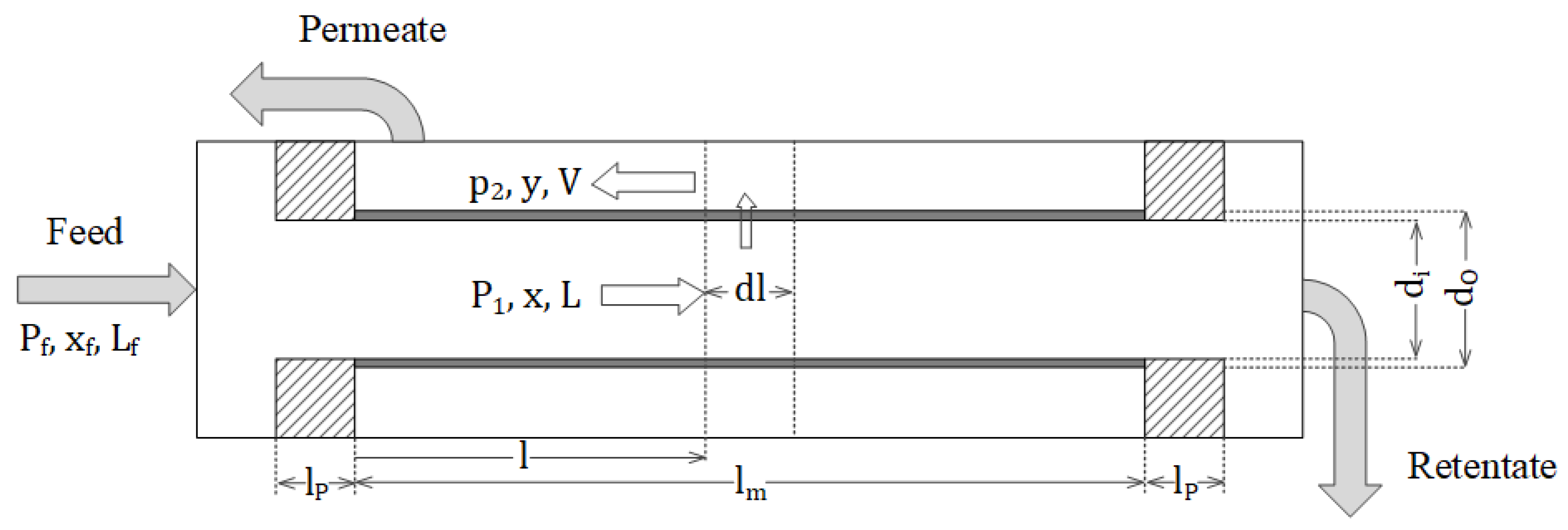



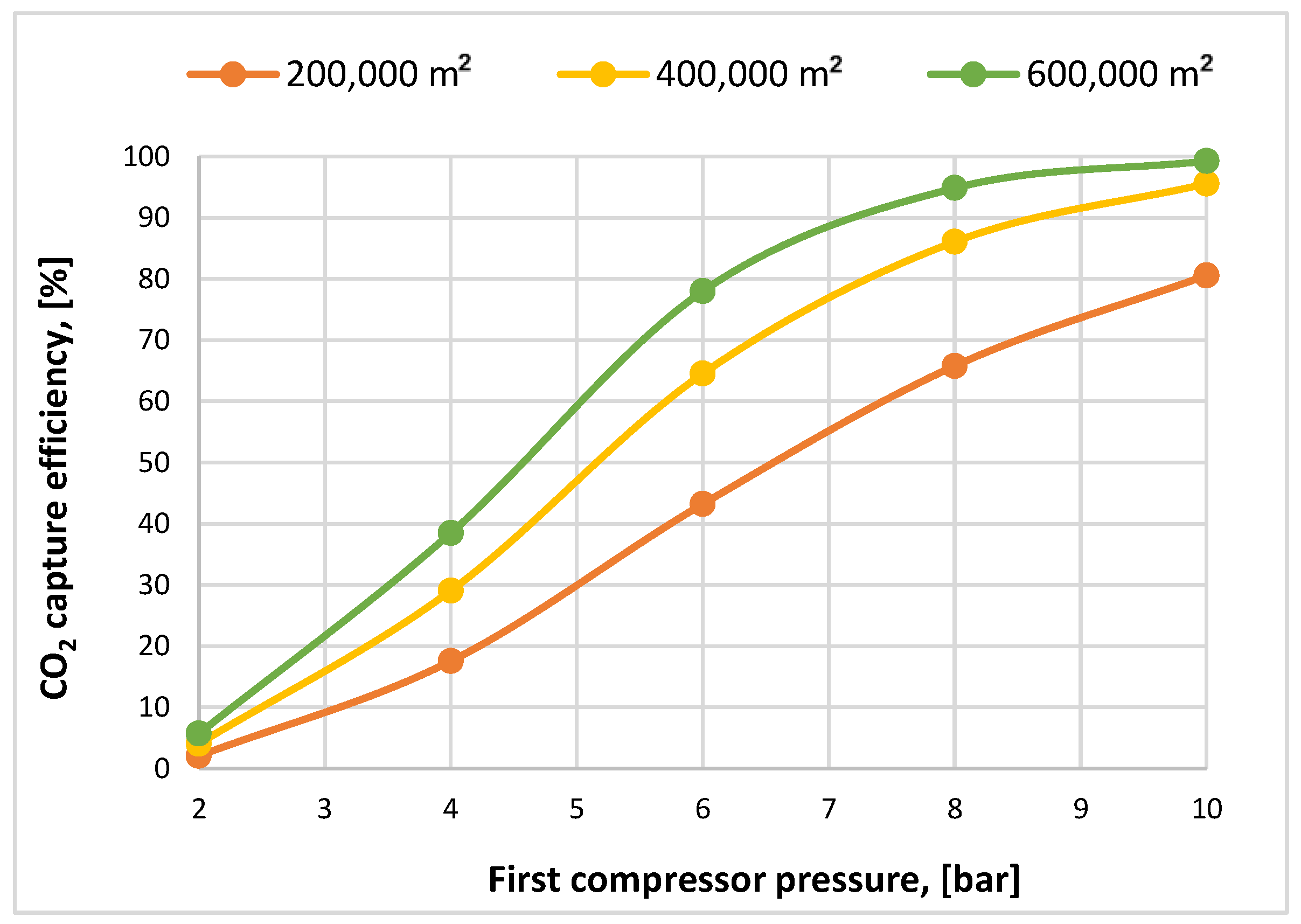

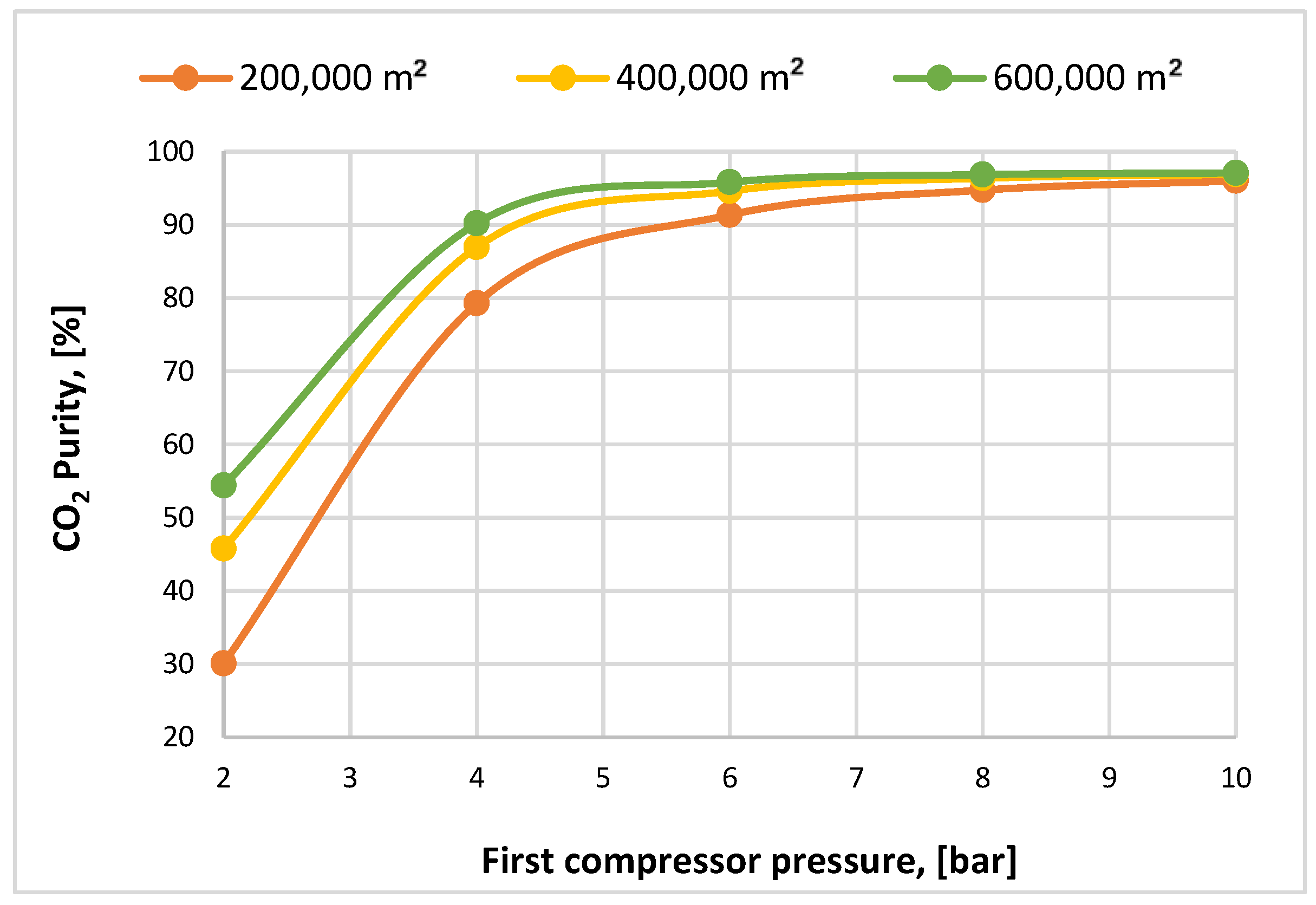
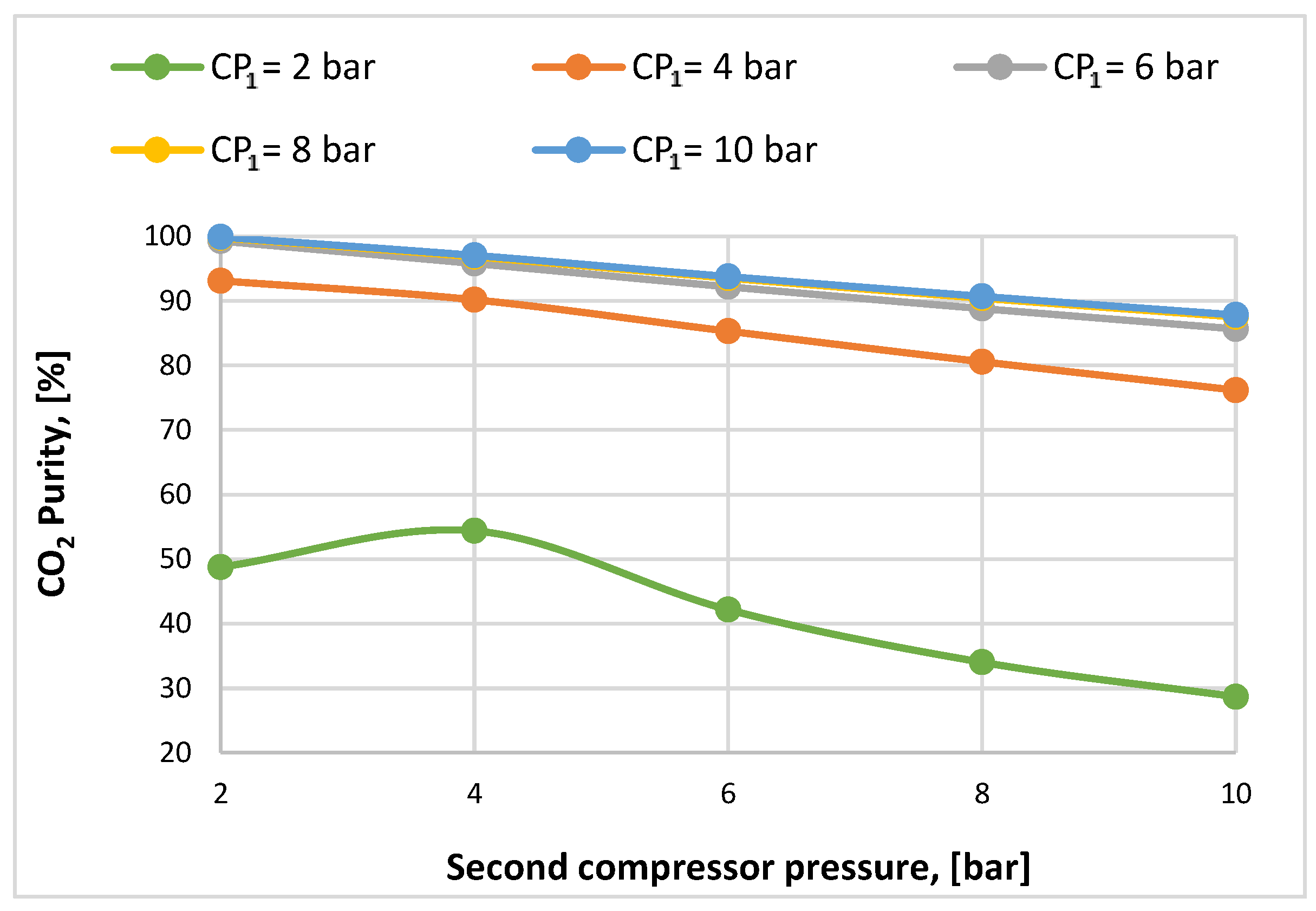
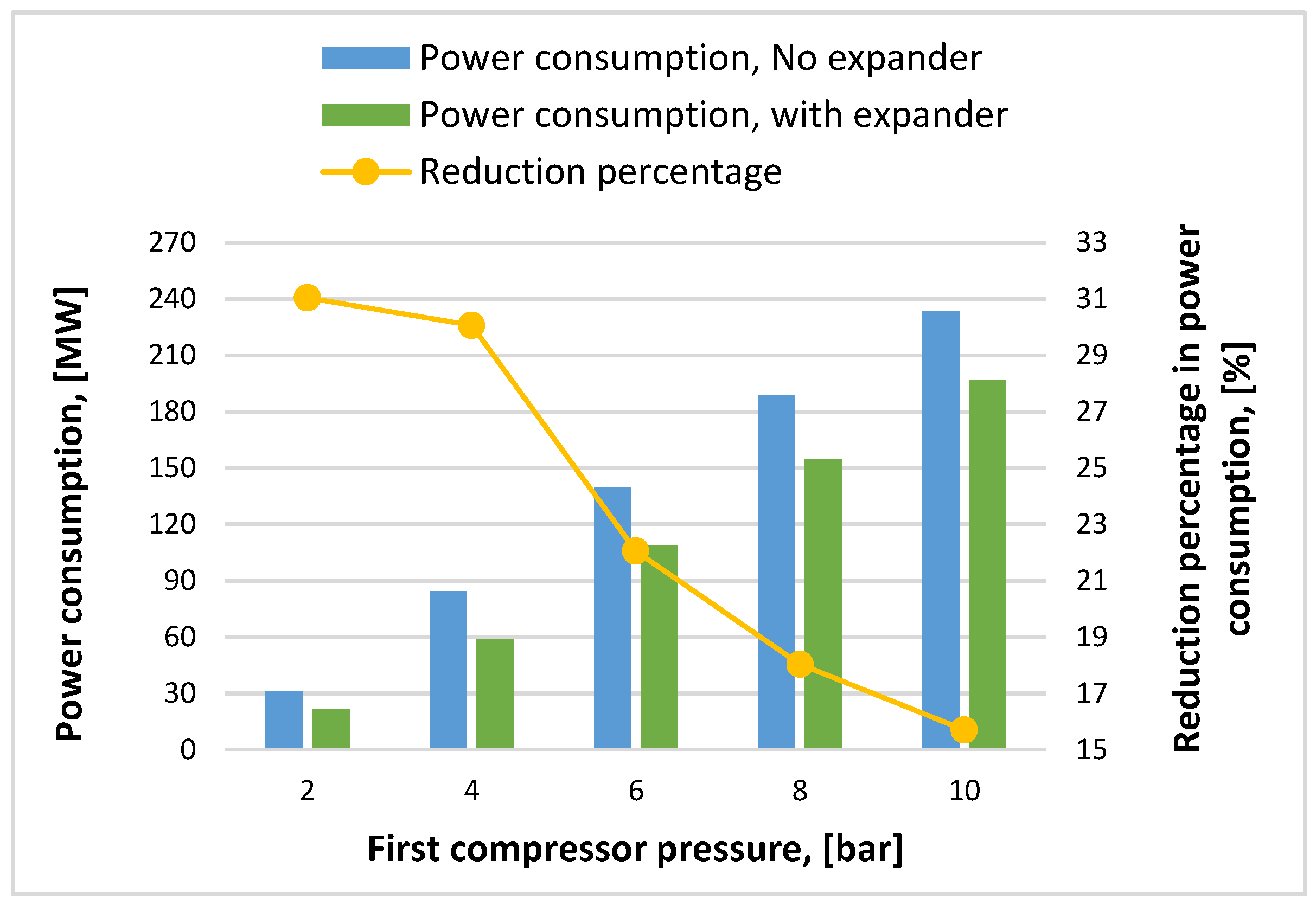
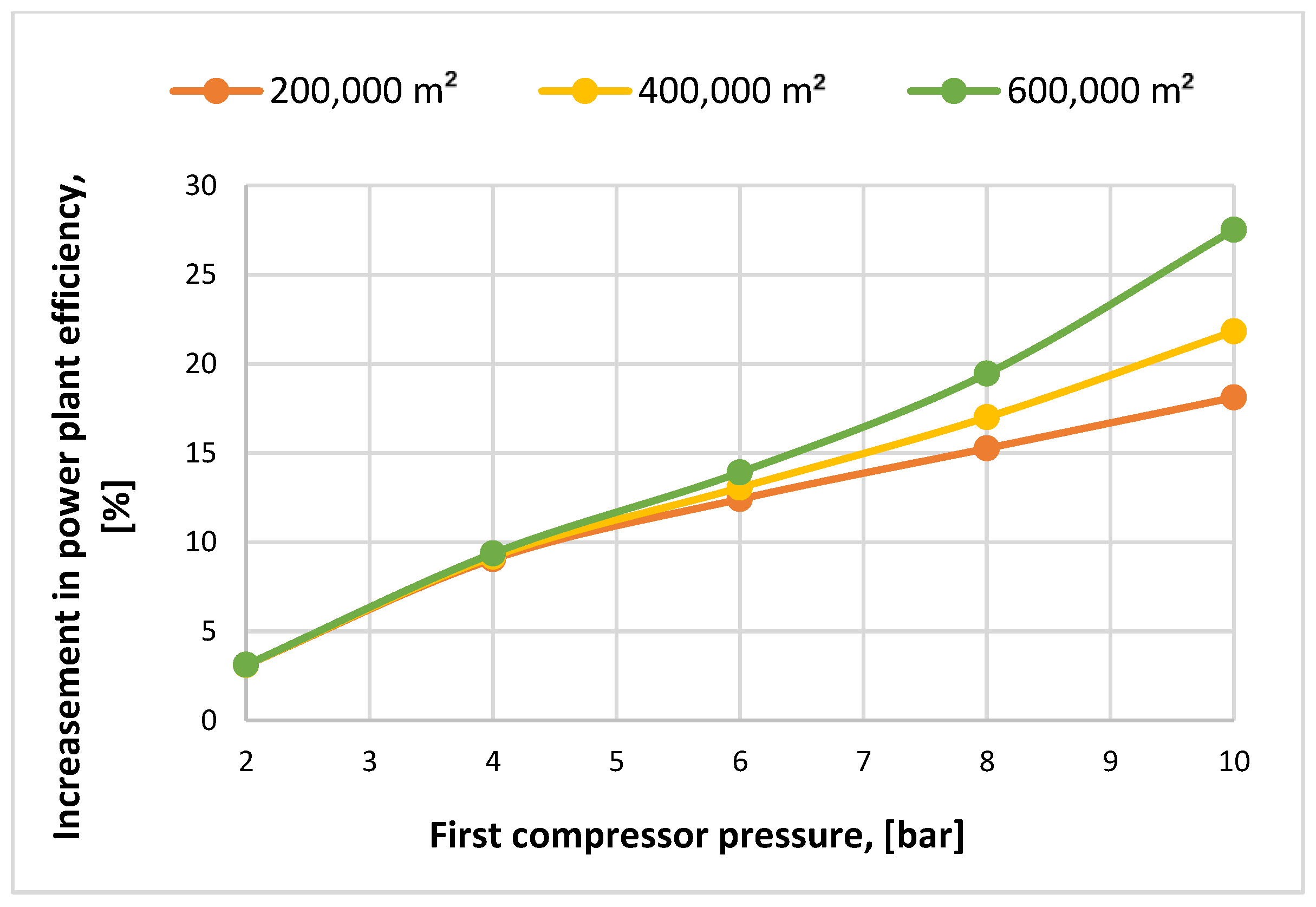
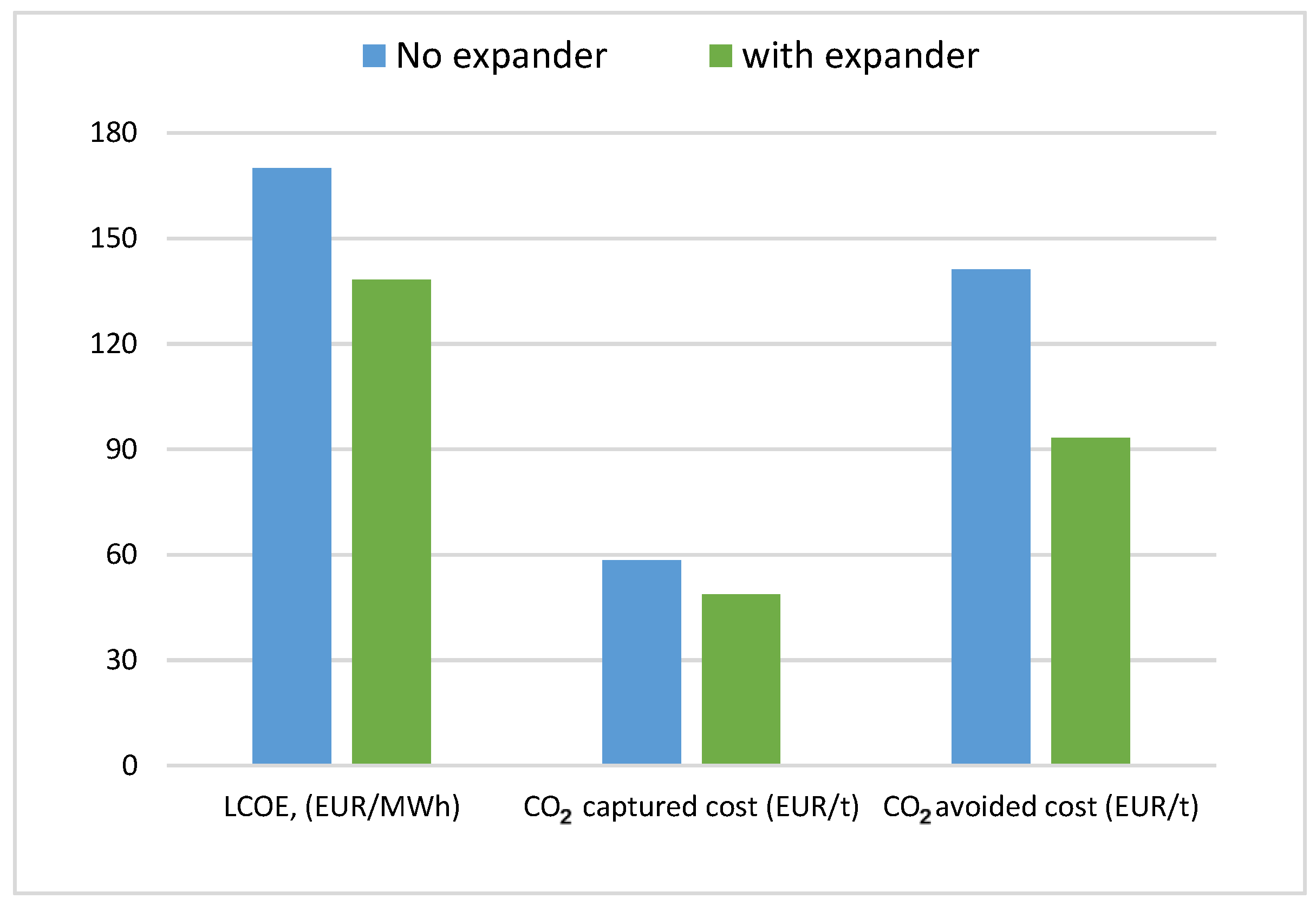

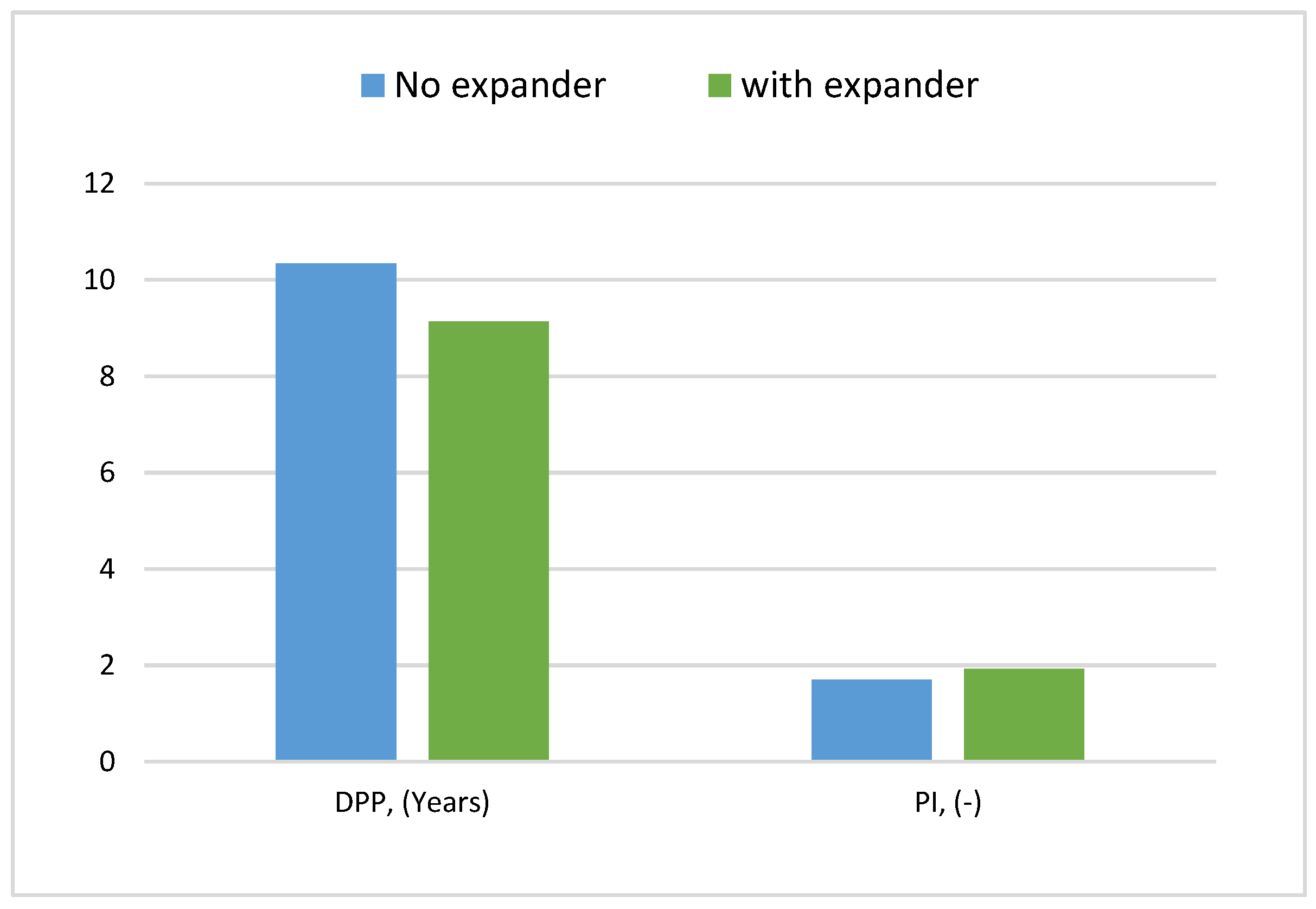
| Factor | Unit | Value |
|---|---|---|
| Membrane type | - | Spiral wound |
| Flow pattern | - | Counter-current |
| CO2 permeability | GPU | 1000 |
| N2 permeability | GPU | 20 |
| CO2/N2 Selectivity | - | 50 |
| Compressor efficiency | % | 90 |
| Expander efficiency | % | 85 |
| Water pump efficiency | % | 90 |
| Water pump pressure | bar | 3 |
| Heat exchanger temperature out (All) | °C | 50 |
| Variance of the membrane variables simulated | ||
| First compressor pressure (CP1) | bar | 2–10 |
| First membrane surface area (MSA1) | m2 | 200,000–600,000 |
| Second compressor pressure (CP2) | bar | 2–6 |
| Second membrane surface area (MSA2) | m2 | 40,000 |
| Indicators | Units | Values |
|---|---|---|
| Project working period | years | 25 |
| Availability factor | % | 85 |
| Price of electricity | EUR/MWh | 160 |
| Fee for CO2 | EUR/t | 82 [53] |
| Annual running hours | h/year | 7446 (85/100 × 8760) |
| Membrane module cost | EUR/m2 | 50 |
| Price of compressor | EUR/kW | 1350 |
| Price of CO2 pump | EUR/kW | 1300 |
| Cost of expander | EUR/kW | 500 |
| Membrane repair cost | EUR/m2 | 10 |
| Labor cost | EUR/h | 15 |
| CO2 compression component | million EUR | 11.7 |
| Separators and Compressor interstage coolers | million EUR | 0.87 |
| Parameters | Power Plant (Base) | Power Plant with Two-Membrane-Stage System | ||||||||
|---|---|---|---|---|---|---|---|---|---|---|
| Membrane area (m2) | n.a. | 200,000 | 400,000 | 600,000 | ||||||
| CP1 (bar) | n.a. | 6 | 8 | 10 | 6 | 8 | 10 | 6 | 8 | 10 |
| Net power generated (MW) | 330 | 265.7 | 238.1 | 213.3 | 245.7 | 208.3 | 174.4 | 226.7 | 180.6 | 138.7 |
| Net power plant efficiency (%) | 45.78 | 40.49 | 36.67 | 33.23 | 37.71 | 32.54 | 27.82 | 35.08 | 28.69 | 22.87 |
| Capital costs per net electrical capacity (EUR/kWh) | 2753.8 | 4213.6 | 4714 | 5272.3 | 4642.5 | 5488.9 | 6572.1 | 5125.4 | 6450.3 | 8419.7 |
| CO2 emission factor (kg/MWh) | 741.15 | 522.84 | 351.46 | 222.77 | 353.25 | 163.41 | 62.28 | 237.37 | 69.73 | 13.05 |
| CO2 captured (kg/MWh) | n.a. | 397.8 | 675.6 | 923.7 | 642.4 | 1010.5 | 1340.4 | 841.6 | 1284.3 | 1750.5 |
| Power consumption of membrane plant (kWe) | n.a. | 69,823 | 97,348 | 122,157 | 89,831 | 127,141 | 161,123 | 108,801 | 154,850 | 196,796 |
| Membrane power consumption (kWh/tCO2) | n.a. | 660.68 | 605.07 | 619.89 | 569.25 | 603.89 | 689.37 | 570.31 | 667.50 | 810.62 |
| LCOE_tax (EUR/kWh) | 0.0756 | 0.1269 | 0.1243 | 0.1263 | 0.1224 | 0.1257 | 0.1410 | 0.1231 | 0.1382 | 0.1757 |
| SPECCA (MJth/kg) | n.a. | 2.58 | 2.89 | 3.22 | 2.62 | 3.17 | 3.79 | 2.85 | 3.65 | 4.50 |
| SEPCCA (MJel/kg) | n.a. | 1.49 | 1.56 | 1.70 | 1.41 | 1.67 | 2.01 | 1.50 | 1.93 | 2.45 |
| CO2 avoided cost (EUR/t) | n.a. | 234.94 | 124.95 | 97.75 | 120.58 | 86.72 | 96.34 | 94.27 | 93.28 | 137.52 |
| CO2 captured cost (EUR/t) | n.a. | 128.93 | 72.07 | 54.86 | 72.81 | 49.58 | 48.79 | 56.43 | 48.77 | 57.20 |
| Parameters | Unit | Values | ||||||||
|---|---|---|---|---|---|---|---|---|---|---|
| MSA1 | m2 | 200,000 | 400,000 | 600,000 | ||||||
| CP1 | bar | 6 | 8 | 10 | 6 | 8 | 10 | 6 | 8 | 10 |
| NPV | Million EUR | 589.7 | 901.9 | 1048.6 | 919.36 | 1123.4 | 1061.92 | 1066.6 | 1080.9 | 827.5 |
| IRR | % | 0.14 | 0.16 | 0.18 | 0.17 | 0.18 | 0.18 | 0.18 | 0.18 | 0.16 |
| DPP | Year | 11.99 | 9.83 | 9.12 | 9.81 | 8.88 | 9.15 | 9.19 | 9.14 | 10.46 |
| PI | - | 1.53 | 1.80 | 1.93 | 1.81 | 1.98 | 1.93 | 1.92 | 1.93 | 1.71 |
| Parameters | Current Paper: Optimum Results | Literature Papers | ||
|---|---|---|---|---|
| [30] | [67] | [68] | ||
| Flue gas flow (feed) (kmol/h) | 40,320 | 67,176 | 95,800 | 18,260 |
| CO2 flow (feed) (kmol/h) | 5290 | 10,278 | 13,163 | 2355.5 |
| Membrane unit number | 2 | 2 | 2 | 2 |
| Total membrane area (×103 m2) | 640 | 1040 | 480 | 679 |
| CO2 permeance (GPU) | 1000 | 1000 | 2200 | 740 |
| CO2/N2 selectivity | 50 | 80 | 50 | 135 |
| CO2 capture efficiency (%) | 94.9 | 90 | 70 | 80.3 |
| CO2 flow captured (kmol/h) | 5020 | 9619 | 9214 | 1884.4 |
| Membrane power consumption (MW) | 154.9 | n.a. | 80 | 23.7 |
| CO2 purity (%) | 96.8 | 80 | 58 | 95.1 |
| LCOE_tax (EUR/kWh) | 0.1382 | n.a. | n.a. | n.a. |
| SPECCA (MJth/kg) | 3.65 | n.a. | n.a. | n.a. |
| SEPCCA (MJel/kg) | 1.93 | n.a. | n.a. | n.a. |
| CO2 avoided cost (EUR/t) | 93.28 | n.a. | n.a. | n.a. |
| CO2 captured cost (EUR/t) | 48.77 | 28.6 | n.a. | 47.87 |
Disclaimer/Publisher’s Note: The statements, opinions and data contained in all publications are solely those of the individual author(s) and contributor(s) and not of MDPI and/or the editor(s). MDPI and/or the editor(s) disclaim responsibility for any injury to people or property resulting from any ideas, methods, instructions or products referred to in the content. |
© 2024 by the authors. Licensee MDPI, Basel, Switzerland. This article is an open access article distributed under the terms and conditions of the Creative Commons Attribution (CC BY) license (https://creativecommons.org/licenses/by/4.0/).
Share and Cite
Alabid, M.; Dinca, C. Membrane CO2 Separation System Improvement for Coal-Fired Power Plant Integration. Energies 2024, 17, 464. https://doi.org/10.3390/en17020464
Alabid M, Dinca C. Membrane CO2 Separation System Improvement for Coal-Fired Power Plant Integration. Energies. 2024; 17(2):464. https://doi.org/10.3390/en17020464
Chicago/Turabian StyleAlabid, Maytham, and Cristian Dinca. 2024. "Membrane CO2 Separation System Improvement for Coal-Fired Power Plant Integration" Energies 17, no. 2: 464. https://doi.org/10.3390/en17020464
APA StyleAlabid, M., & Dinca, C. (2024). Membrane CO2 Separation System Improvement for Coal-Fired Power Plant Integration. Energies, 17(2), 464. https://doi.org/10.3390/en17020464







